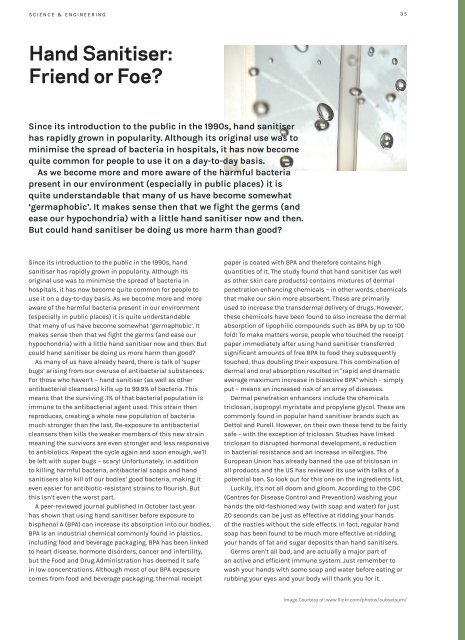You also want an ePaper? Increase the reach of your titles
YUMPU automatically turns print PDFs into web optimized ePapers that Google loves.
SCIENCE & ENGINEERING 35<br />
Hand Sanitiser:<br />
Friend or Foe?<br />
Since its introduction to the public in the 1990s, hand sanitiser<br />
has rapidly grown in popularity. Although its original use was to<br />
minimise the spread of bacteria in hospitals, it has now become<br />
quite common for people to use it on a day-to-day basis.<br />
As we become more and more aware of the harmful bacteria<br />
present in our environment (especially in public places) it is<br />
quite understandable that many of us have become somewhat<br />
‘germaphobic’. It makes sense then that we fight the germs (and<br />
ease our hypochondria) with a little hand sanitiser now and then.<br />
But could hand sanitiser be doing us more harm than good?<br />
Since its introduction to the public in the 1990s, hand<br />
sanitiser has rapidly grown in popularity. Although its<br />
original use was to minimise the spread of bacteria in<br />
hospitals, it has now become quite common for people to<br />
use it on a day-to-day basis. As we become more and more<br />
aware of the harmful bacteria present in our environment<br />
(especially in public places) it is quite understandable<br />
that many of us have become somewhat ‘germaphobic’. It<br />
makes sense then that we fight the germs (and ease our<br />
hypochondria) with a little hand sanitiser now and then. But<br />
could hand sanitiser be doing us more harm than good?<br />
As many of us have already heard, there is talk of ‘super<br />
bugs’ arising from our overuse of antibacterial substances.<br />
For those who haven’t – hand sanitiser (as well as other<br />
antibacterial cleansers) kills up to 99.9% of bacteria. This<br />
means that the surviving .1% of that bacterial population is<br />
immune to the antibacterial agent used. This strain then<br />
reproduces, creating a whole new population of bacteria<br />
much stronger than the last. Re-exposure to antibacterial<br />
cleansers then kills the weaker members of this new strain<br />
meaning the survivors are even stronger and less responsive<br />
to antibiotics. Repeat the cycle again and soon enough, we’ll<br />
be left with super bugs – scary! Unfortunately, in addition<br />
to killing harmful bacteria, antibacterial soaps and hand<br />
sanitisers also kill off our bodies’ good bacteria, making it<br />
even easier for antibiotic-resistant strains to flourish. But<br />
this isn’t even the worst part.<br />
A peer-reviewed journal published in october last year<br />
has shown that using hand sanitiser before exposure to<br />
bisphenol A (BPA) can increase its absorption into our bodies.<br />
BPA is an industrial chemical commonly found in plastics,<br />
including food and beverage packaging. BPA has been linked<br />
to heart disease, hormone disorders, cancer and infertility,<br />
but the Food and Drug Administration has deemed it safe<br />
in low concentrations. Although most of our BPA exposure<br />
comes from food and beverage packaging, thermal receipt<br />
paper is coated with BPA and therefore contains high<br />
quantities of it. The study found that hand sanitiser (as well<br />
as other skin care products) contains mixtures of dermal<br />
penetration enhancing chemicals – in other words, chemicals<br />
that make our skin more absorbent. These are primarily<br />
used to increase the transdermal delivery of drugs. However,<br />
these chemicals have been found to also increase the dermal<br />
absorption of lipophilic compounds such as BPA by up to 100<br />
fold! To make matters worse, people who touched the receipt<br />
paper immediately after using hand sanitiser transferred<br />
significant amounts of free BPA to food they subsequently<br />
touched, thus doubling their exposure. This combination of<br />
dermal and oral absorption resulted in "rapid and dramatic<br />
average maximum increase in bioactive BPA" which – simply<br />
put – means an increased risk of an array of diseases.<br />
Dermal penetration enhancers include the chemicals<br />
triclosan, isopropyl myristate and propylene glycol. These are<br />
commonly found in popular hand sanitiser brands such as<br />
Dettol and Purell. However, on their own these tend to be fairly<br />
safe – with the exception of triclosan. Studies have linked<br />
triclosan to disrupted hormonal development, a reduction<br />
in bacterial resistance and an increase in allergies. The<br />
European Union has already banned the use of triclosan in<br />
all products and the US has reviewed its use with talks of a<br />
potential ban. So look out for this one on the ingredients list.<br />
Luckily, it’s not all doom and gloom. According to the CDC<br />
(Centres for Disease Control and Prevention) washing your<br />
hands the old-fashioned way (with soap and water) for just<br />
20 seconds can be just as effective at ridding your hands<br />
of the nasties without the side effects. In fact, regular hand<br />
soap has been found to be much more effective at ridding<br />
your hands of fat and sugar deposits than hand sanitisers.<br />
Germs aren’t all bad, and are actually a major part of<br />
an active and efficient immune system. Just remember to<br />
wash your hands with some soap and water before eating or<br />
rubbing your eyes and your body will thank you for it.<br />
Image Courtesy of: www.flickr.com/photos/subsetsum/


















